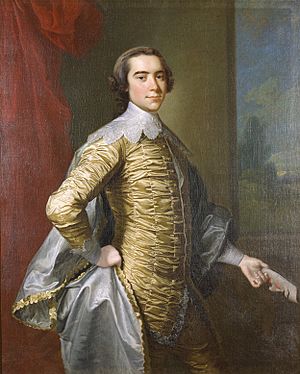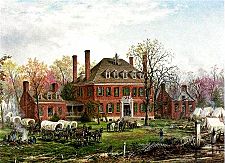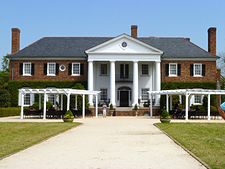Planter class facts for kids

The planter class was a group of people in the Americas who owned large farms called plantations. These farms grew crops like tobacco, cotton, and sugar cane. To work these farms, planters often used enslaved people from Africa. This class was very powerful and wealthy, especially in the 17th and 18th centuries.
In the Southern United States, planters had a special way of life. It was similar to the rich families in Britain. They valued good manners, politeness, and being welcoming. This culture was different from the northern and western parts of the U.S., where most farms were smaller and worked by families without enslaved labor.
After the American Civil War (1861–1865), slavery was ended in the United States. This greatly reduced the wealth of many planter families. Many plantations then used a system called sharecropping. In this system, formerly enslaved African Americans worked the land and shared the crops with the landowner. Today, some old plantations are museums, showing what life was like back then.
Planters were found in many European colonies across North America, South America, and the Caribbean. Famous planters include George Washington and Thomas Jefferson, who were also Founding Fathers of the U.S.
Contents
History of Planters
Early Plantations
When Europeans first came to the Americas, they were looking for gold and silver. But they soon found that the new lands could also grow valuable crops. Brazil became the first major plantation colony in 1532, growing sugar, which was very popular in Europe. Other European countries soon wanted their own profitable colonies. Many Europeans who were unhappy with the strict social rules in their home countries moved to the Americas, hoping for new opportunities.
Early settlers arrived in the late 1500s and early 1600s. They faced a wild and sometimes dangerous new land. At first, they were just farmers, trying to grow enough food for their settlements. Native Americans helped them by teaching them how to grow local plants like tobacco and sugar. These crops later became huge industries that supported the slave trade. Over time, wealthy landowners who wanted to develop these businesses began to control colonial politics.
To help pay for wars in Europe, governments started giving land in the colonies to soldiers, especially officers, for their service. This encouraged military people to settle in the Americas. They helped defend the colonies against other European settlers and Native American tribes.
Growth of Plantation Farming
John Rolfe, a settler in Jamestown, was the first European to grow tobacco in North America. He brought tobacco seeds from Trinidad and harvested his first crop in 1612. This tobacco was sold in Europe. By the 1630s, ships were carrying 1.5 million pounds of tobacco from the Chesapeake Bay area each year. By the end of the 1600s, this grew to about 40 million pounds. Planters borrowed money from London to fund their farms. When tobacco prices fell in the 1750s, many plantations struggled. To avoid financial ruin, planters tried to grow more crops or switched to growing cotton or wheat.
In 1720, coffee was brought to the West Indies. A French naval officer named Gabriel de Clieu brought a coffee plant from Paris to Martinique. He planted it on a mountain, and by 1726, he had his first coffee crop. Within 50 years, Martinique had 18,000 coffee trees. Coffee growing then spread to other Caribbean islands. By 1788, the French colony of Saint-Domingue (now Haiti) produced half of the world's coffee. These French plantations relied heavily on enslaved African laborers. The extremely harsh conditions for enslaved people on coffee plantations led to the Haitian Revolution.
Revolution and Ending Slavery
In the 1700s, a period called the Age of Enlightenment spread new ideas in Europe. Philosophers like Montesquieu and Denis Diderot wrote against slavery. They questioned if it was right or fair. In the French West Indies, there were laws called the Code Noir that gave some rights to enslaved people, like the right to marry. However, slave owners often ignored these laws and made their own stricter rules.
An Enlightenment writer named Guillaume Raynal criticized slavery in 1780. He even predicted a large slave revolt in the colonies. In Saint-Domingue, sugar was produced under very difficult conditions. Diseases like malaria were common. White planters lived in fear of slave rebellions. To control enslaved people, masters often overworked them, gave them little food and shelter, and used harsh punishments. Enslaved people who escaped were called Maroons. They hid in the jungles and sometimes raided plantations. In April 1791, a huge slave uprising began, showing strong resistance to slavery.
During the French Revolution, on February 4, 1794, France and its colonies officially ended slavery. The ideas of equality from the French Revolution spread across Europe. This made other European powers question the practice of slavery in their own colonies.
In England, slavery was made illegal in 1772 after a court case. In 1783, a movement to end slavery began in Britain. A group of Quakers started the first British anti-slavery group. William Wilberforce led the fight in Parliament to end the slave trade. His efforts led to the Slave Trade Act 1807, which stopped the trading of enslaved people in the British Empire. He continued to work for the complete end of slavery, which happened with the Slavery Abolition Act 1833.
Plantation Architecture
A plantation house was the main building where the owner's family, guests, and house slaves lived. These houses often started small but grew larger and more impressive as the planter became wealthier. They often featured large Greek Revival columns, curved stairs, and other popular architectural styles of the time.
French Colonial Style
The French settlers in Canada, Louisiana, and Saint-Domingue influenced French Colonial architecture. This style is known for its wide roofs that extend over porches, thin wooden columns, and living areas raised off the ground. Colonists learned building methods from the West Indies. They designed houses that were practical for areas that often flooded.
Many French Colonial plantation homes in Louisiana were lost when the economy shifted from farming to industry after the Civil War.
Georgian Style
Georgian architecture was very popular in the Thirteen Colonies during the 1700s. American Georgian buildings were often made of wood. Even columns were shaped from timber. At first, it was hard to get bricks or stone, so wood was a common choice, unless the building was in a big city or bricks were available nearby.
A great example of Georgian planter architecture is Westover Plantation. It was built in the mid-1700s for William Byrd III. The main entrance has a fancy doorway, known as "the Westover doorway," which stands out from the otherwise simple building. During the American Civil War, the house was used as a headquarters by Union General Fitz John Porter. Part of the house was damaged by a cannonball during the war. It was later rebuilt and modernized.
Palladian Style
Palladian architecture became popular in America in the 1720s. It was used for colleges and public buildings, and many homes were built in this style, like Monticello. Andrea Palladio developed Palladianism in the 1500s. He published a book with his architectural drawings.
Palladian buildings often have covered porches with columns that are a main feature of the front of the house. Red brick exteriors and slanted or domed roofs are common for homes in this style.
Monticello, the home of U.S. President Thomas Jefferson, has a unique style that he created. This style has been copied in many colleges, like The Rotunda at the University of Virginia, as well as churches and other public buildings.
 In Spanish: Clase de plantadores para niños
In Spanish: Clase de plantadores para niños






